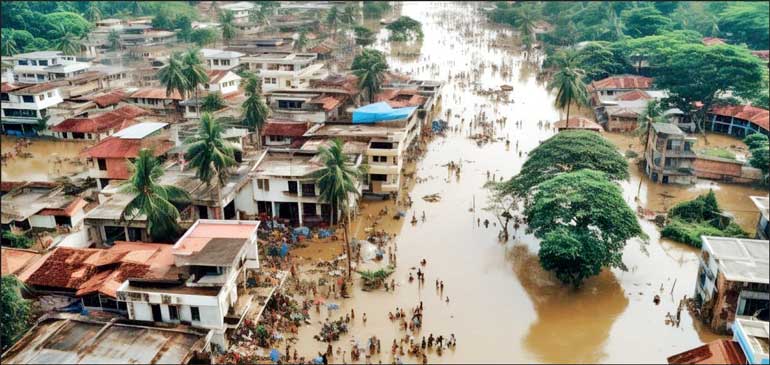Sunday Dec 21, 2025
Sunday Dec 21, 2025
Friday, 21 July 2023 00:00 - - {{hitsCtrl.values.hits}}

Countries across the world must adapt their risk management frameworks and mechanisms to address climate impacts and climate-induced loss and damage
 In the era of anthropogenic climate change, countries such as Sri Lanka face a complex landscape of risks. Climate risks exacerbate and interact with other categories of risks, including market volatility, production risks, or supply chain disruptions. They can affect large numbers of people at the same time and take the form of extreme events (e.g., floods, droughts, storms) or long-term processes (e.g., sea level rise, salinisation, soil erosion, or reduced rainfall reliability).
In the era of anthropogenic climate change, countries such as Sri Lanka face a complex landscape of risks. Climate risks exacerbate and interact with other categories of risks, including market volatility, production risks, or supply chain disruptions. They can affect large numbers of people at the same time and take the form of extreme events (e.g., floods, droughts, storms) or long-term processes (e.g., sea level rise, salinisation, soil erosion, or reduced rainfall reliability).
In their various forms, climate risks threaten people’s lives and wellbeing as well as livelihoods and prosperity, leading to significant impacts on the overall economy and development of countries.
Climate-vulnerable countries must adapt their risk management frameworks and mechanisms to address these defining challenges of the 21st Century. On the hand, risk management is an important part of climate change adaptation and can help communities or sectors to not only withstand shocks but also capitalise on new markets, skill sets, technologies, and nature-based opportunities. On the other hand, it is critical to minimise climate-induced loss and damage, which can have severe long-term consequences, is often irreversible, and may permanently erode coping capacities against other risks.
Comprehensive risk management and loss and damage
Comprehensive risk management starts with assessing and understanding current and emerging risks, which includes mapping hazards, exposure, vulnerability, and coping or adaptive capacities. This includes weather and climate data and projections in line with different global scenarios, but also information on local circumstances, demographic and social factors, ecosystems, and economic aspects.
Once risks have been identified through an assessment process, there are various methods to reduce them to a certain extent, such as through protective infrastructure, adapted equipment, or better practices and protocols. Remaining risks can be shared among multiple stakeholders (e.g., through a farmer association or village savings fund), transferred (e.g., through insurance or catastrophe bonds), or smoothed (e.g., through informal support systems). What remains is residual risk—i.e., the risk that could not be prevented, reduced, or transferred and is instead being retained (e.g., in the form of contingency funds or budget reallocation).
Together, these different aspects of risk management and the multitude of their associated tools and mechanisms create an ecosystem of risk management.
Existing ecosystems of risk management
Vulnerable developing countries across the world already have existing mechanisms or schemes that address risks and shocks through various means. This can be in the form of public insurance schemes, cash transfers, in-kind support programmes (such as school feeding) or informal risk pooling, covering different risks on the micro, meso, or macro level.
Sri Lanka, for example, already has an ecosystem of risk management that comprised or comprises a variety of institutions, actors, policies, plans, regulations, mechanisms, and schemes. This includes a compulsory crop insurance mechanism that has been active since the late 1950s; a national natural disaster insurance scheme; a loan protection scheme covering financial institutions; disaster relief; social protection and support systems; and subsidies to key commodities.
For this ecosystem to provide protection and services to households, communities, and key economic sectors, it requires inputs in the forms of funding, data, technology, equipment, and support. Currently, most of these inputs in developing countries come from domestic sources: either the affected communities themselves, who are forced to use their own limited resources to pay for damages (e.g., by selling off assets, reducing consumption, abandoning traditional livelihoods, or migrating away), or the government, further constricting fiscal space and increasing the debt burden. Taking the example of public risk transfer in Sri Lanka, most of the funding comes from the national budget allocation, sometimes with additional contributions from affected communities (e.g., farmers paying a small premium) or other actors (e.g., crop levy of 1% of profits on all financial institutions).
The need for finance and support
Comprehensive risk management frameworks, including risk transfer and finance solutions, can provide support to vulnerable groups and communities and build on existing institutional structures in developing countries, such as extension officers, agro-advisory systems, databases, or data collection mechanisms.
However, access to additional funding is needed to sustain such systems and respond to emerging needs in the face of increasing climate impacts and climate-induced loss and damage. Sources of additional funding could include existing climate funds (e.g., the Green Climate Fund or the Climate Investment Funds), the new Loss and Damage Fund under the United Nations Framework Convention on Climate Change and the Paris Agreement, development funding, or multilateral initiatives such as the Global Shield against Climate Risks, a G7/V20 collaboration launched in 2022.
In addition to finance, there are also other potential areas in need of support. To enhance existing risk management systems and develop innovative solutions for the emerging challenges of a warming world, key factors include access to detailed weather data, projections, and risk analytics; education systems that strengthen financial literacy and inclusion; digitised data management and frontier technologies; improved distribution channels; inclusive and participatory processes; gender mainstreaming; youth empowerment; and a mindset shift towards pre-arranged and anticipatory finance and risk transfer solutions that include all actors along the value chain.
With climate change projected to lead to more frequent and intense impacts, it is vital to prepare accordingly and invest in systems that can minimise risks, adapt to a changing environment, and address unavoidable losses and damages in equitable, inclusive, and effective ways.
(The writer works as Director: Research and Knowledge Management at SLYCAN Trust, a non-profit think tank based in Sri Lanka. His work focuses on climate change, adaptation, resilience, ecosystem conservation, just transition, human mobility, and a range of related issues. He holds a Master’s degree in Education from the University of Cologne, Germany and is a regular writer to several international and local media outlets.)